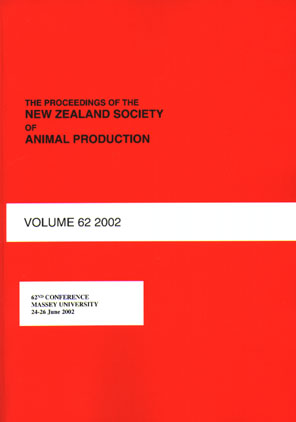Abstract
The effects of two high-endophyte perennial ryegrass cultivars (‘Aries HD’ or ‘Yatsyn 1’) on the performance of lactating dairy cows were investigated during a two-year trial. Spring calved cows (Year 1, n = 359; Year 2, n = 570) were allocated to one of two herds. Herds grazed the cultivars as part of each grazing rotation from November to May for the 1997/98 and 1998/99 seasons. Milksolids production was higher (P<0.001) from the Aries HD herd compared with the Yatsyn 1 herd (228 vs. 202 kg MS/herd/day, Year 1; 340 vs. 294 kg MS/herd/day, Year 2, Aries HD and Yatsyn 1 herds, respectively) (P < 0.001). Milk fat % and protein % did not differ significantly (P>0.1) between herds. Significantly (P<0.001) more body condition (+0.8 of one body condition score) and more live weight (+17 kg) was gained by cows grazing Aries HD during Year 2. Interval from start of mating to predicted conception tended to be longer for cows grazing Yatsyn 1 (+ 6 days) during Year 1 (P = 0.06). Significantly different cow performance from ryegrass cultivars that produce similar yields of dry matter may be due partly to differences in forage quality and endophyte toxins. Aries HD tended to be more digestible than Yatsyn 1 and was associated with lower concentrations of ergovaline, an alkaloid produced by Neotyphodium endophytes that has been associated previously with reduced animal performance.
Proceedings of the New Zealand Society of Animal Production, Volume 60, Hamilton, 247-252, 2000
| Download Full PDF | BibTEX Citation | Endnote Citation | Search the Proceedings |

This work is licensed under a Creative Commons Attribution-NonCommercial-NoDerivatives 4.0 International License.

